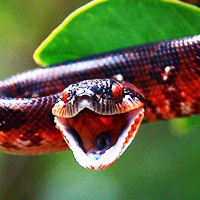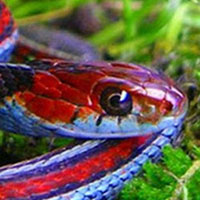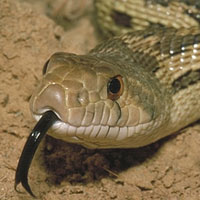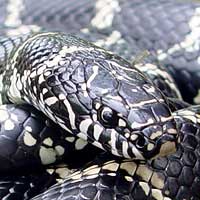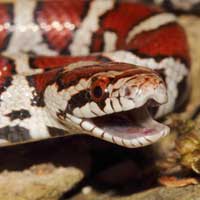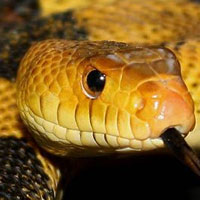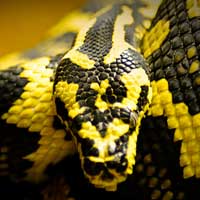Prairie Kingsnake: Everything You Need to Know About This Adaptable Reptile
The scientific name of the Prairie Kingsnake is Lampropeltis calligaster. It belongs to the Colubridae family, which includes a wide variety of non-venomous and mildly venomous snake species.
Scientific Name: Lampropeltis calligaster
Snake Family: Colubridae
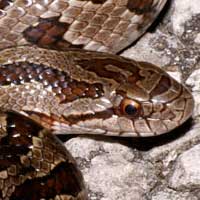
Introduction to the Prairie Kingsnake
The Prairie Kingsnake (Lampropeltis calligaster) is a non-venomous snake native to the central and southeastern United States. Known for its adaptability and mild temperament, this snake features a variety of earthy brown and gray patterns that help it blend into its surroundings. Its role as a predator makes it an essential part of its ecosystem, controlling populations of rodents and other small animals.
Where Does the Prairie Kingsnake Live?
The Prairie Kingsnake thrives in a variety of habitats, demonstrating its adaptability to different environments. From prairies to suburban areas, it is highly versatile in its choice of living spaces.
Preferred Habitat Features:
- Grasslands and open fields
- Wooded areas and forest edges
- Farmlands and agricultural zones
- Suburban backyards with ample cover
| Region | Habitat Type | Key Features |
|---|---|---|
| Midwestern USA | Grasslands | Open fields, small prey availability |
| Southeastern USA | Woodlands | Shaded areas, dense vegetation |
| Suburban Areas | Gardens and fields | Proximity to human activity |
What Does the Prairie Kingsnake Eat?
The Prairie Kingsnake is a carnivorous predator with a diverse diet. Its feeding habits are one of its strongest assets, allowing it to thrive in various environments.
Common Diet:
- Rodents such as mice and rats
- Lizards
- Birds and their eggs
- Amphibians such as frogs and toads
In captivity, feeding frozen-thawed rodents is the most practical and safe option. Juveniles should be fed every 5-7 days, while adults can be fed every 10-14 days. Be sure to offer prey that is appropriately sized for the snake to prevent choking or regurgitation.
Behavior and Temperament of the Prairie Kingsnake
The Prairie Kingsnake is known for its docile and calm demeanor, making it a popular choice among reptile enthusiasts. Although generally shy, it is not prone to aggression.
Key Behavioral Traits:
- Non-aggressive and mild-tempered
- Active during the day and early evening
- May vibrate its tail or hiss when threatened
- Skilled at burrowing and hiding
With regular, gentle handling, the Prairie Kingsnake adapts well to human interaction and becomes a manageable pet for keepers of all experience levels.
Health and Lifespan of the Prairie Kingsnake
The Prairie Kingsnake is a hardy species with a lifespan of 12-20 years in captivity when provided with proper care. Regular monitoring of its health and environment is essential for its well-being.
Common Health Concerns:
- Respiratory infections caused by improper humidity
- Shedding issues due to low humidity
- Internal and external parasites
Maintain a temperature gradient of 75-85°F, provide clean water for hydration and soaking, and ensure a clean enclosure to prevent health issues. Regular check-ups with a reptile veterinarian are recommended.
Reproductive Traits of the Prairie Kingsnake
The Prairie Kingsnake is oviparous, meaning it lays eggs after mating. Breeding typically occurs in the spring, followed by egg-laying in early summer.
Reproductive Details:
- Mating season: Spring
- Clutch size: 5-12 eggs
- Incubation period: 50-70 days
- Hatchlings are independent at birth
In captivity, providing a nesting box and maintaining proper incubation temperatures (82-85°F) are crucial for successful breeding.
How to Handle and Care for the Prairie Kingsnake
Caring for a Prairie Kingsnake involves creating an environment that mimics its natural habitat and providing consistent, gentle handling.
Handling and Care Tips:
- Handle gently to reduce stress and build trust
- Provide an enclosure with hiding spots and climbing branches
- Maintain proper humidity and temperature levels
- Offer a balanced diet of appropriately sized prey
With proper care and attention, the Prairie Kingsnake can thrive in captivity, offering years of fascination and companionship to its keeper.
Other Snakes In This Species
 Albino California Kingsnake
Albino California Kingsnake Arizona Mountain Kingsnake
Arizona Mountain Kingsnake Black Kingsnake
Black Kingsnake Brooks Kingsnake
Brooks Kingsnake California Kingsnake
California Kingsnake Desert Kingsnake
Desert Kingsnake Dot-Dash California Kingsnake
Dot-Dash California Kingsnake Durango Mountain Kingsnake
Durango Mountain Kingsnake Eastern Kingsnake
Eastern Kingsnake Florida Kingsnake
Florida Kingsnake Florida Mole Kingsnake
Florida Mole Kingsnake Goins Kingsnake
Goins Kingsnake Gray Banded Kingsnake
Gray Banded Kingsnake Mexican Black Kingsnake
Mexican Black Kingsnake Mole Kingsnake
Mole Kingsnake Prairie Kingsnake
Prairie Kingsnake Ruthvens Kingsnake
Ruthvens Kingsnake Scarlet Kingsnake
Scarlet Kingsnake Speckled Kingsnake
Speckled Kingsnake Utah Mountain Kingsnake
Utah Mountain Kingsnake Variable Kingsnake
Variable Kingsnake
